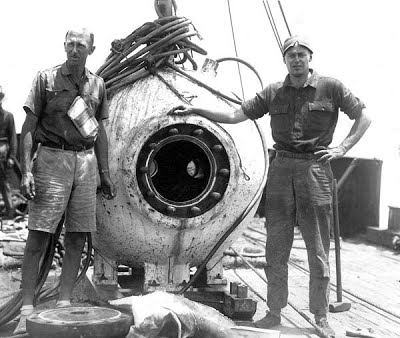"All her decks were visible to me. From all the hatchways a storming, despairing mass of men were fighting their way on deck, grimy stokers, officers, soldiers, groom, cooks. They all rushed, ran, screamed for boats, tore and thrust one another from the ladders leading down to them, fought for the lifebelts and jostled one another on the sloping deck. All amongst them, rearing, slipping horses are wedged. The starboard boats could not be lowered on account of the list; everyone therefore ran across to the port boats, which in the hurry and panic, had been lowered with great stupidity either half full or overcrowded. The men left behind were wringing their hands in despair and running to and fro along the decks; finally they threw themselves into the water so as to swim to the boats." - Adolf K.G.E von Spiegel, 1919.
War
John Phillip Holland
John Philip Holland created the first modern submarine by uniting the internal combustion engine, the electric motor, and the electric battery. The HMS Holland which was built in 1900 was their first ship sold for the British Navy.
"April 11, 1900 was the date that the U.S Navy accepted Holland No.6, a 53- foot craft displacing 75 tons" - Steel Boats, Iron Men, 1973, Mike H. Rindskopf
“The submersible craft of to-day is no longer an ingenious toy; it is a practical engine of warfare of no mean value. But there is vast room for improvement in its design. It must be endowed with more speed, its longitudinal stability must be improved, and its appliances for under-water vision perfected.” - Royal Societies’ Club, (Submarine Warfare, Past and Present by Herbert C. Fyfe, 1917
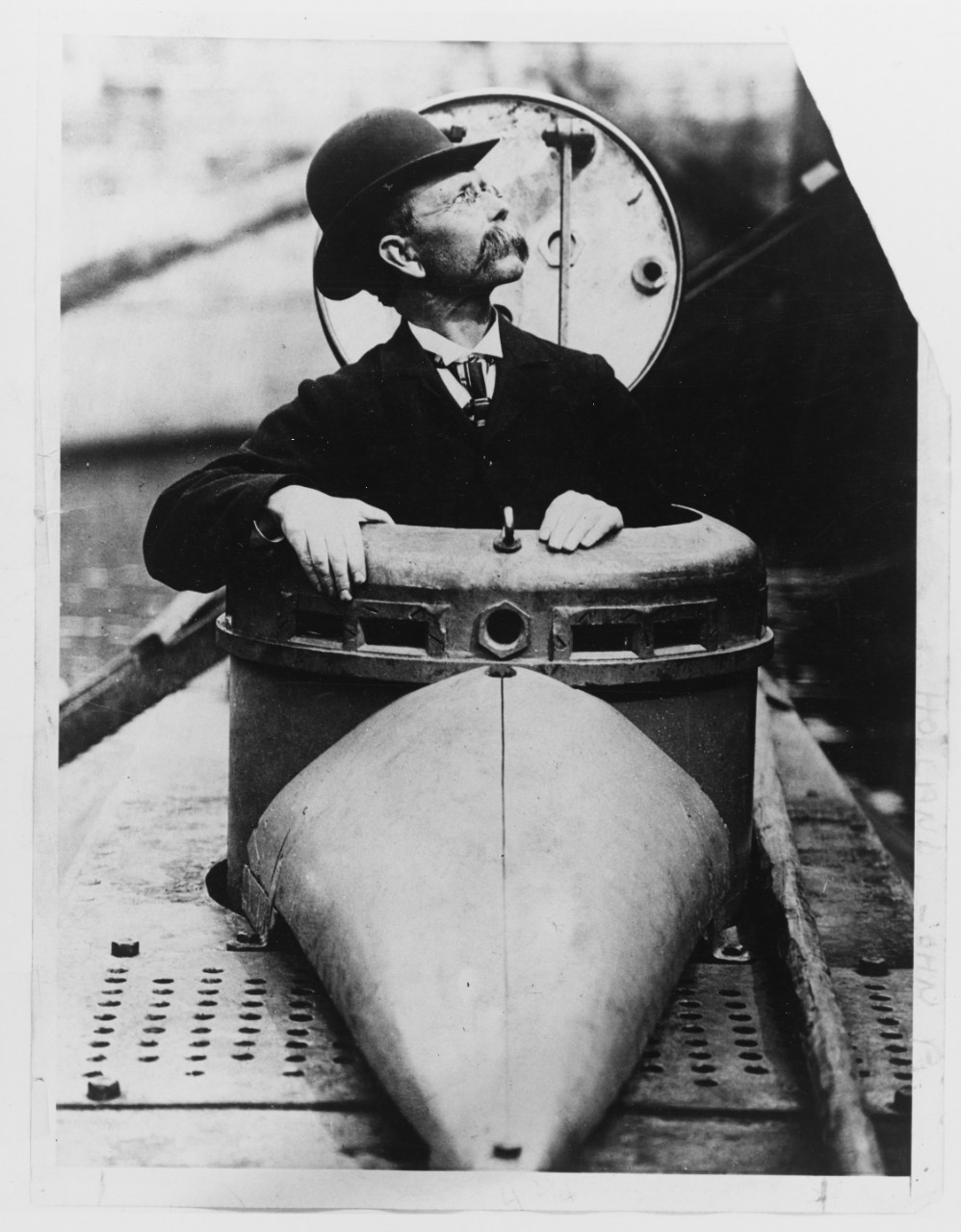
John Philip Holland, U.S. American engineer (1841-1914), 1900
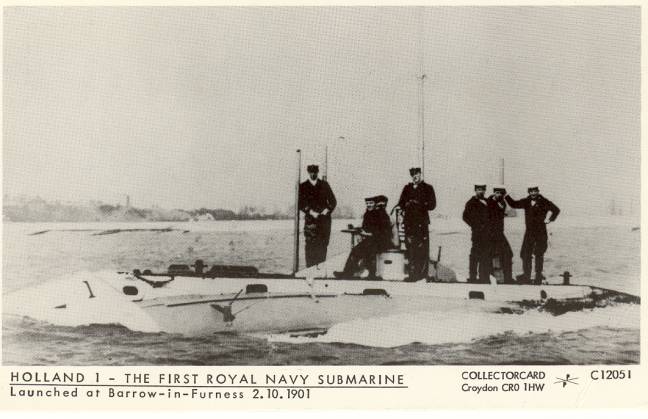
HMS Holland Under Way, 1900, Collectorcard
“The submersible craft of to-day is no longer an ingenious toy; it is a practical engine of warfare of no mean value. But there is vast room for improvement in its design. It must be endowed with more speed, its longitudinal stability must be improved, and its appliances for under-water vision perfected.” - Royal Societies’ Club, (Submarine Warfare, Past and Present by Herbert C. Fyfe), 1917
Torpedo
The torpedo was a projectile that submarines fired to sink other submarines/ships. The torpedo is self-propelled, and the first torpedoes were powered by compressed air which turned two pistons that turned the propeller, but had a flaw, the propeller left bubbles that told the position of the torpedo, giving time to avoid it. Modern ones use a small electric motor to power their torpedo, which did not give off the bubbles.
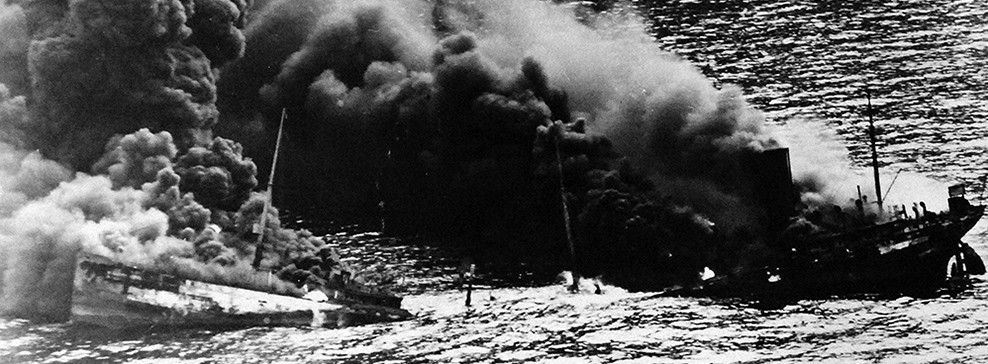
Sinking of SS Dixie Arrow, March 26, 1942
World War I
U-Boats
The U-boat is a German Submarine used in WW1 that shows how effective submarines were at destroying ships, destroying around 3 million tons of shipping in Jan 1917 - Aug 1917 alone. However they were too slow and very vulnerable only traveling 13 knots at top speed and chose not to attack battleships, but instead attack merchant vessels, having two periods of unrestricted warfare, attacking any ship, whether it be passenger liner or merchant ship, in 1915 and 1917.
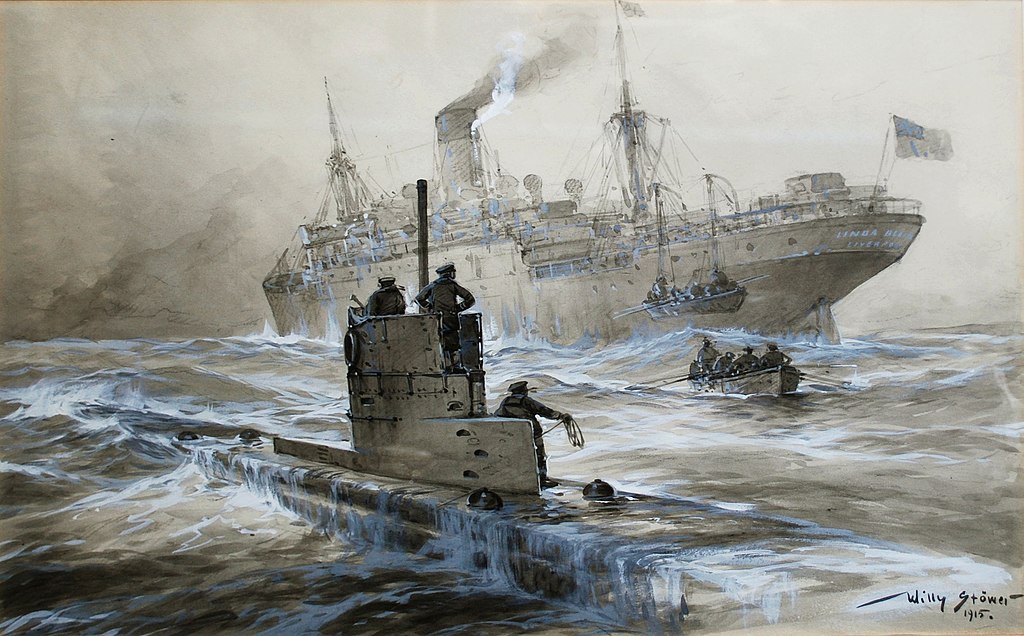
Sinking of the Linda Blanche out of Liverpool by SM U-21, Willy Stower, 1915

The Chronicle’s front page from May 8, 1915, covers the sinking of the Lusitania.
Sinking of the Lusitania
On May 7th, 1915, the Lusitania was torpedoed off the coast of Ireland by U-20 and over 1198 people were killed including 128 Americans, which was one of the leading causes of the U.S joining the war.
"The screams of the women and children were terrible to hear. Wives being torn apart from their husbands and lifted into lifeboats. Children who in the terrible crush of humans had become seperated from their parents , were being handed man to man and into the boats" - Second class passenger Pheobe Amory, 1915
"Mr. Friend struck his fist in his hand and said "By Jove, they've got us." The ship steadied herself for a few seconds and then listed heavily to starboard, throwing us against the wall of a small corridor we had quickly turned into. We then started up to the boat deck... The deck looked very strange, crowed with people and I remember that two women were crying in a pifully weak way" - First Class Passenger Theodate Pope Riddle, 1915
World War II
U-Boats
The U-boat was a notorious predator in WW2 known for destroying almost 3000 ships making the Atlantic transit in an effort to choke Britain from resources to make them surrender and end the war . While they did not succeed, their high death toll was due to the development of new torpedoes that allowed their boat to attack and sink ships from afar.
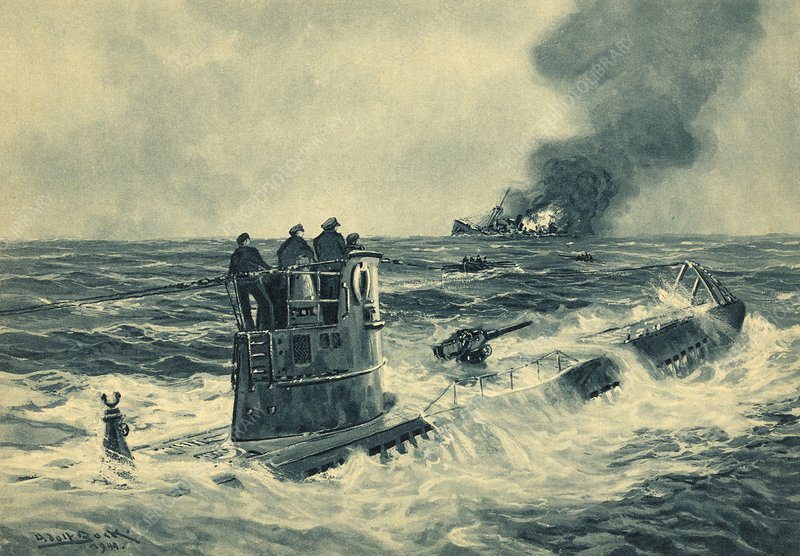
German U-boat Attack, 1941, Adolf Bock
"The only thing that ever really frightened me during the war was the U-Boat peril...It did not take the form of flaring battles and glittering achievements, it manifested itself through statistics, diagrams, and curves unknown to the nation, incomprehensible to the public." - Winston Churchill, 1943
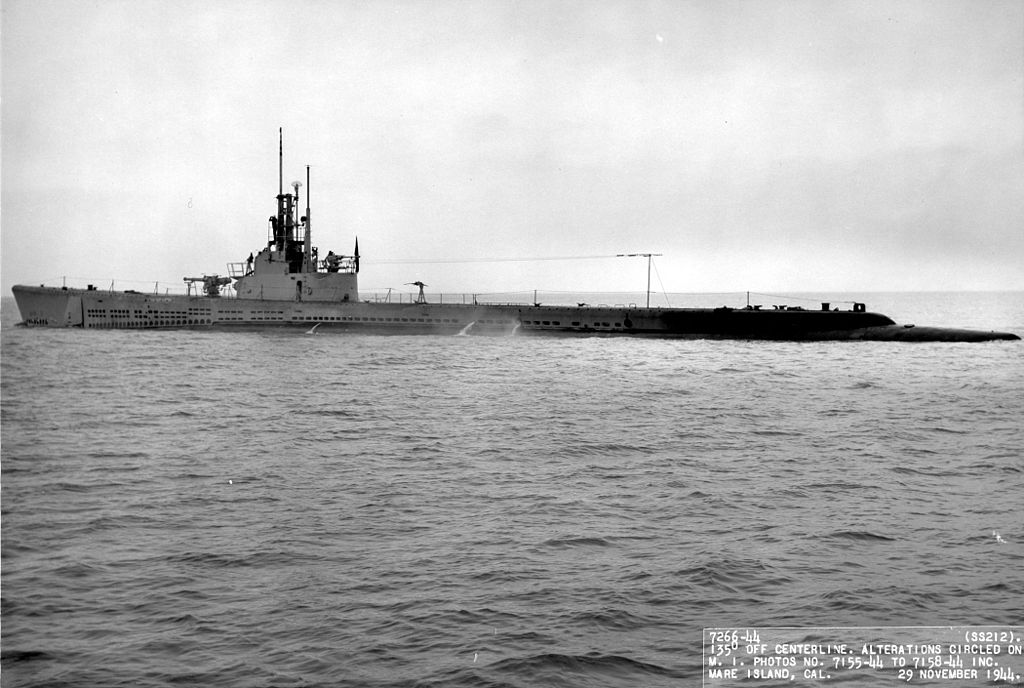
Gato (SS-212), off Mare Island Navy Yard, 29 November 1944.
U.S. Submarines
U.S submarines were influential in the Pacific theater by strangling Japan's essential supply routes and ended up destroying about 4 million tons of shipping, crippling the Japanese force and key to winning the war, as the Japanese supply lines were crippled and could not supply Japan. These submarines had a length of nearly 300 feet, and it had two hulls, and it weighed in at 1500 tons on the surface, 2400 when submerged.
Nuclear Submarines
USS Nautilus
The USS Nautilius was the first nuclear submarine and proved the new deadliness of submarines by traveling 3000 kilometers, under the north pole to the other side of the globe, without surfacing, and showed that now submarines could strike from anywhere on the planet.
“Viewed from the top of the world, this area resembles a huge funnel, with the spout—the Bering Strait—lying to the south. There the ice is far more irregular and hazardous than that on the Greenland side. Blown southward against the walls of the funnel, represented by Alaska and Siberia, the ice ‘chokes up’ at the narrow mouth. In fact, it jams, layer upon layer against these rugged
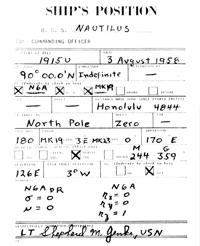
Navigator’s position report to the captain of the
USS Nautilus at the North Pole, December 12, 1951, U.S Navy
coastlines, and as a result is far thicker than the ice near the North Pole. To make matters worse, the waters of the Strait and Chukchi Sea are quite shallow, averaging not more than 120 feet, much too shallow for ordinary submarine operations. If a submarine in those waters encountered deep-hanging ice, it might not be able to get beneath or around it. It would be a hair-raising problem of threading through dangerous ice, seeking out the few deeper ocean-floor valleys which lead northward in the Arctic Basin.” -Captain Anderson, 1957
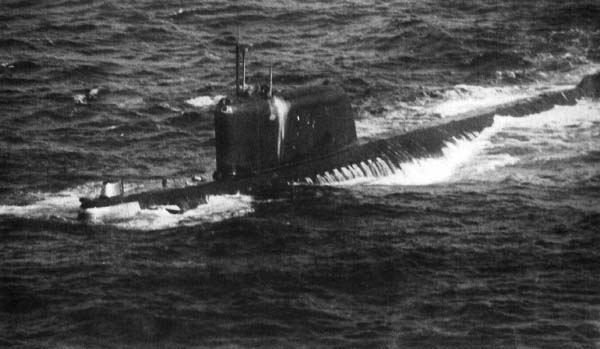
Problem-plagued K-19, disabled in the North Atlantic on 29 February 1972.
USSR Nuclear Submarines
The Russian submarines had serious problems with their nuclear submarines, the most notable being K-19 which suffered a nuclear coolant leak because the Russians were reckless and built it too fast, and the crew tried to fix it. After they succeeded, all of the crew got radiation exposure and ten died from overdose
“Right on the spot their appearances began changing. Skin not protected by clothing began to redden, face and hands began to swell. Dots of blood began to appear on their foreheads, under their hair. Within two hours we couldn’t recognize them ... People died fully conscious, in terrible pain. They couldn’t speak, but they could whisper. They begged us to kill them.” - Captain Zayteyev, 1951.
Cuban Missile Crisis
During the Cuban missile crisis, four Foxtrot class Russian submarines were carrying military supplies to Cuba, to help build missile silos to threaten the U.S after the U.S put silos near Italy and Turkey. B-59 was found by U.S forces and the captain (Valentin Savistky) reacted to a non-lethal depth charge by trying to fire a nuclear torpedo thinking it was lethal.
“We’re gonna blast them now! We will die, but we will sink them all – we will not become the shame of the fleet.” - Valentin Savistky, 1962
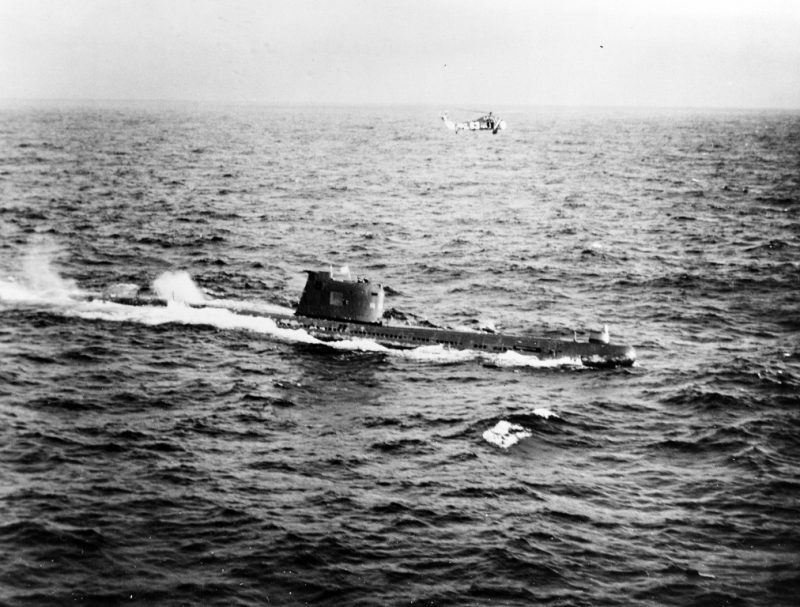
"A Navy Helicopter Hovers Over a Russian Submarine", U.S Navy, 1962
But Vasili Arkhipov, his second in command, stopped him and averted nuclear war, by not allowing Savistky to torpedo the ships.
"He always thought that he did what he had to do and never considered his actions as heroism. He acted like a man who knew what kind of disasters can come from radiation, he did his part for the future so that everyone can live on our planet.” - Elena Andriukova, 1982
